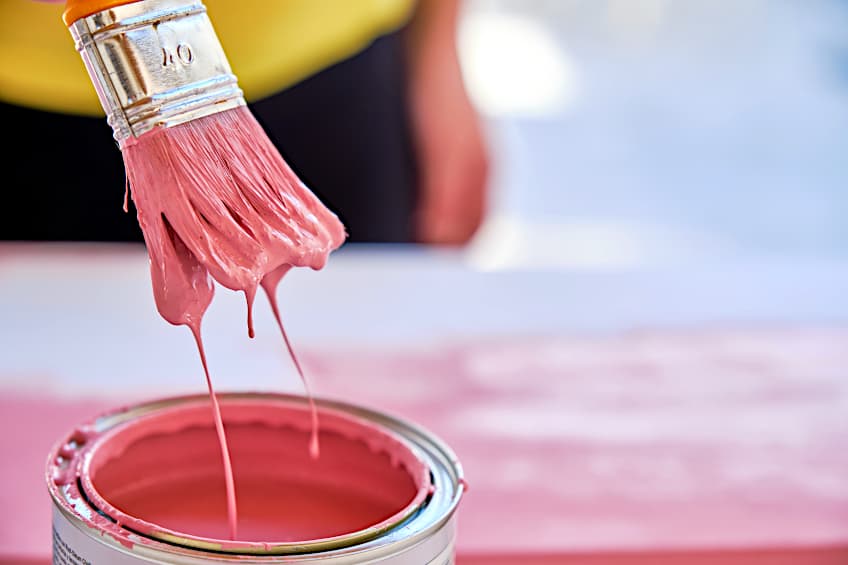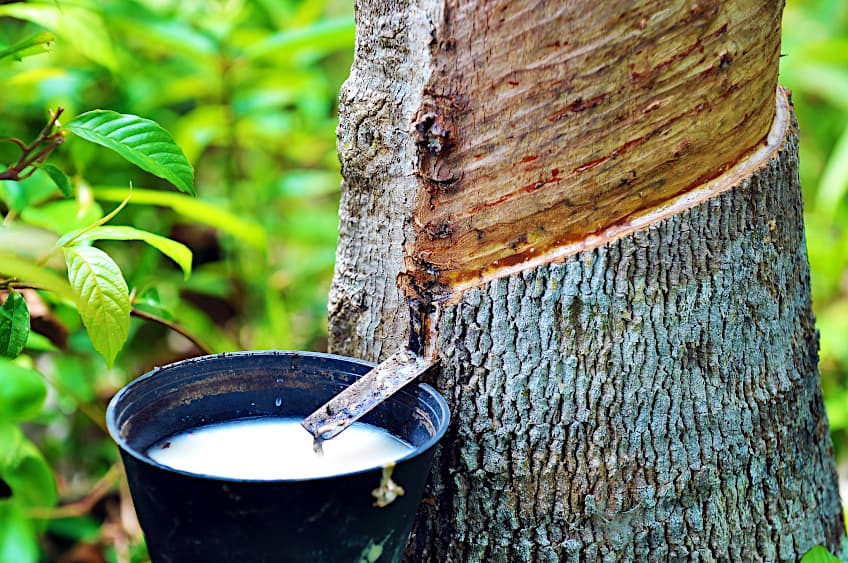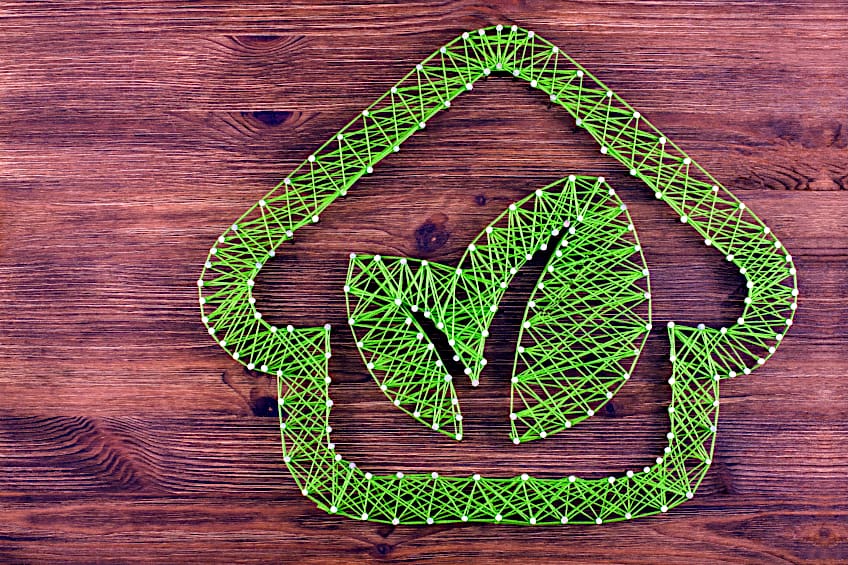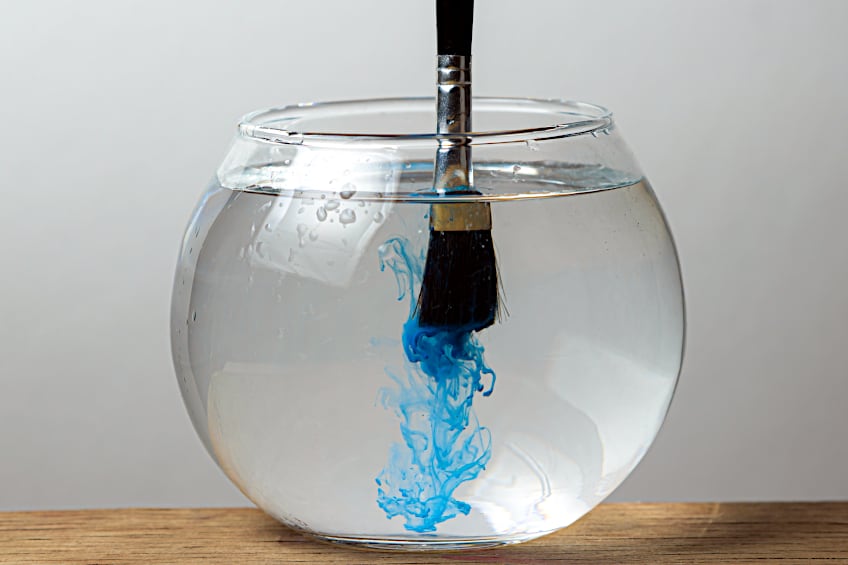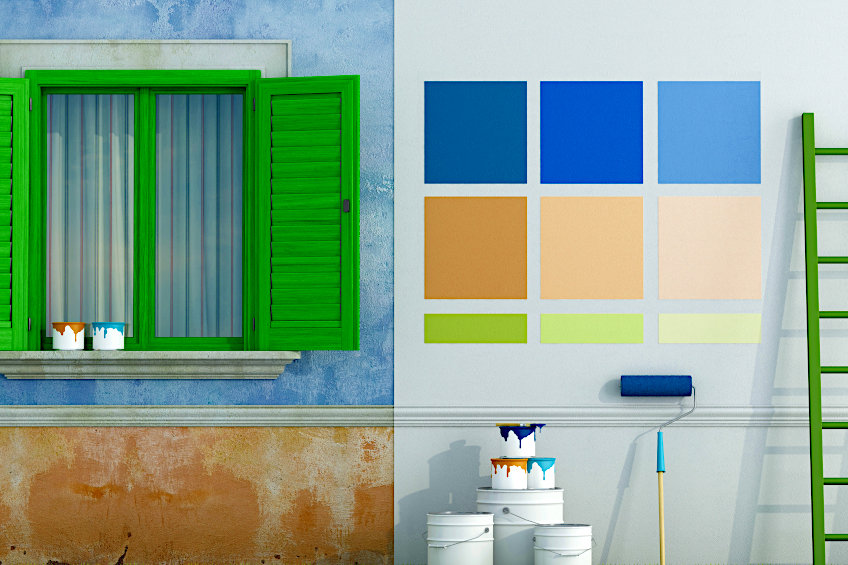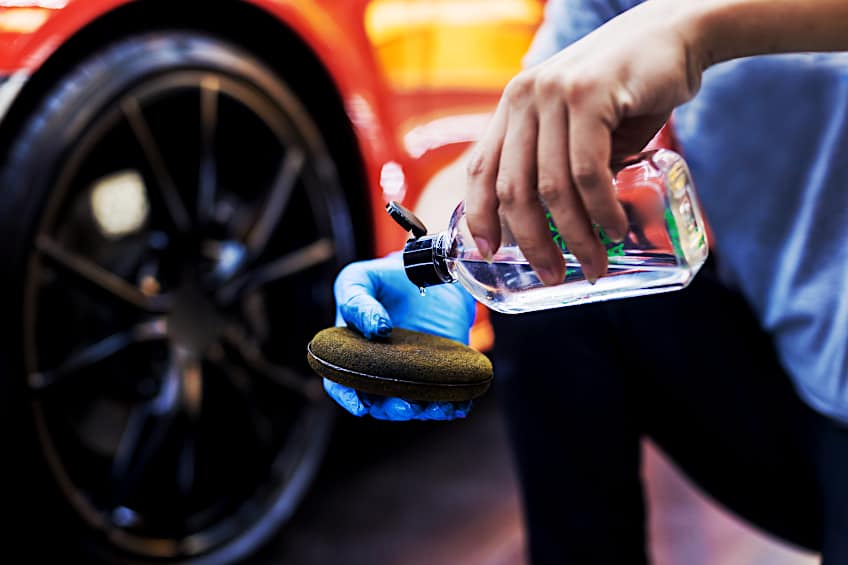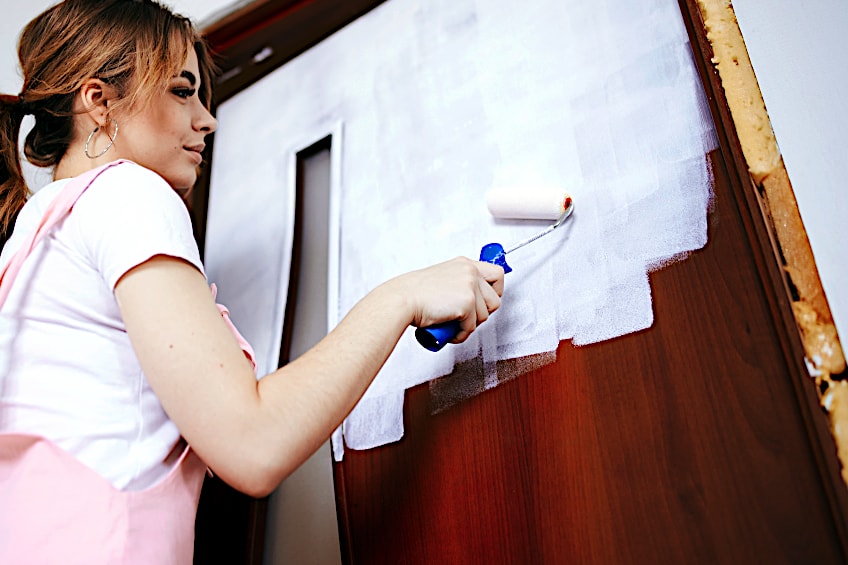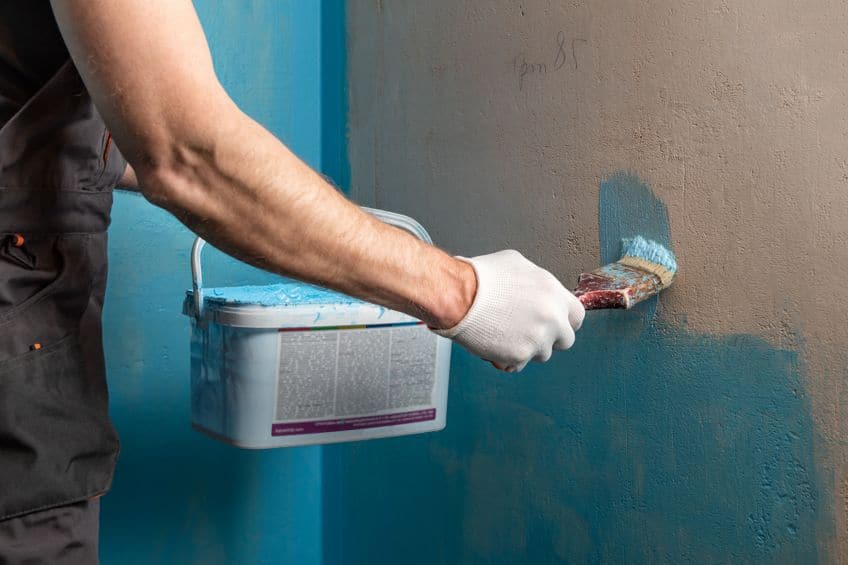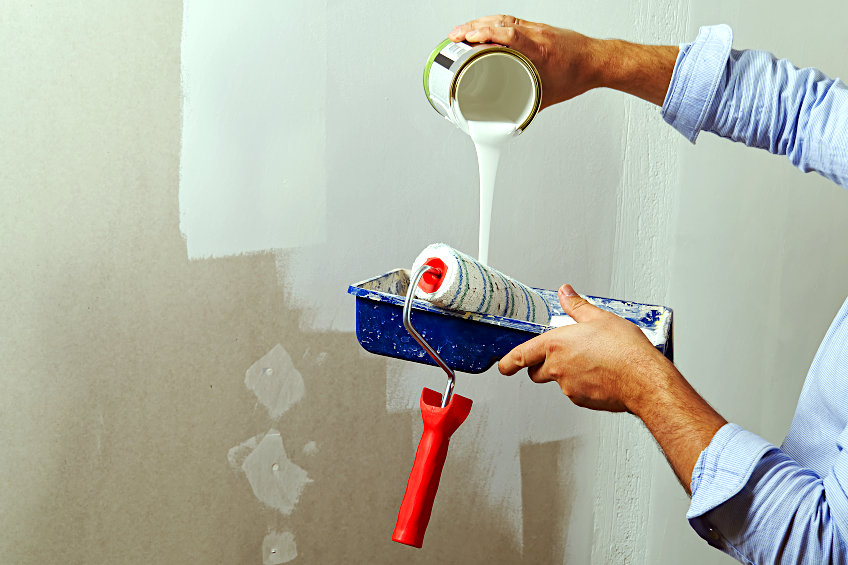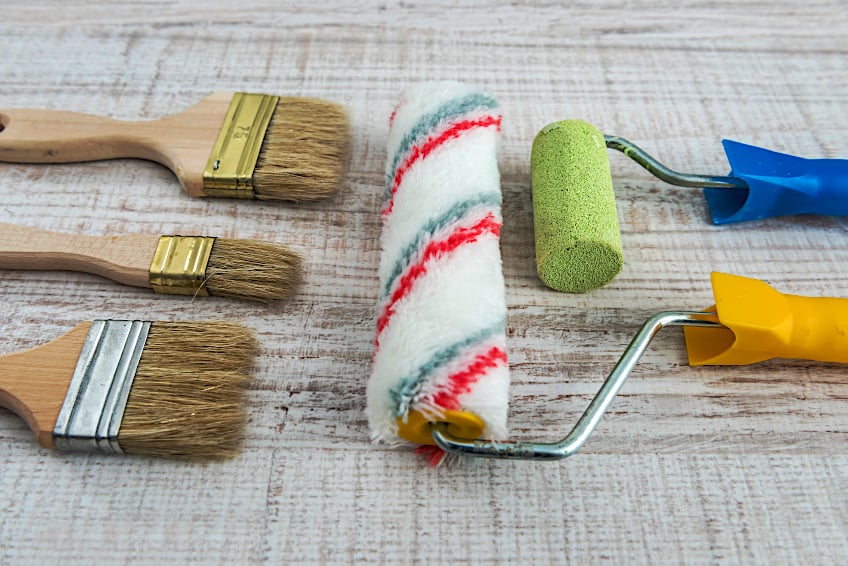Guide to Water-Based Paint – Types, Characteristics, and Benefits
This post may contain affiliate links. We may earn a small commission from purchases made through them, at no additional cost to you. You help to support resin-expert.com
Back in the day, the types of paint available on the market were limited. Oil-based paint was the most popular, but only later on did we realize how bad this paint type was for the environment and our personal health. We continued to use oil-based paints due to their inherent durability, but as time went on, we discovered better and less harmful paint formulas that could be used as a substitute for oil-based paint. One of these paint types was water-based paints, which are still widely used today. If you aren’t sure what water-based paints are, we’ve prepared a short guide to water-based paint, how it works, what variations you’ll encounter, and where its use is most applicable.
Table of Contents
What Is Water-Based Paint?
Paint wasn’t always the substance we know today. Before the advent of mass production and chemical research, people had to make their own paint using things that occurred around them naturally. Early paints were made of everything from berries to leaves, and even traces of blood and viscera, but this would eventually change.
All paint types are a combination of dying agent, pigment, and binder (or base). Before modern solvents and solutions, people would use things like eggs and milk to create the base of their paints, with varying degrees of success mind you. Thankfully, in the 1900s, a company named DP Flinn would develop and patent the very first formula for what we now know as water-based paint.
What is water-based paint though? The formula was far different from the water-based paint composition we know today, consisting primarily of water (of course), zinc oxide, milk, linseed oil, and a type of resin. This was revolutionary at the time, but thankfully development would continue until we discovered that latex polymer was an ever better base for water-based paints in the 1940s.
When latex polymer was introduced, it allowed manufacturers to produce higher-quality water-based paints, and people seemed to notice. Not only did the latex polymer change the consistency and quality of the paint, but it also made it more versatile. It is the combination of all these factors that led to water-based paints becoming even more popular than oil-based ones.
One of the best things about water-based paints is that it has the versatility of many other paint types but without the drawbacks of containing loads of VOCs (volatile organic chemicals). This meant that latex paint could be used both indoors and outdoors without the need for extreme ventilation techniques.
What Are the Benefits of Water-Based Paint?
Every paint type has its unique advantages and disadvantages. Water-based paint is no exception to the rule, and as you’ll see there are many reasons why it surpassed other paint types in popularity at the time of its introduction. Here are a few key characteristics of water-based paint that make it a popular paint type even today!
It’s Environmentally Friendly
We mentioned previously that water-based paint set itself apart from existing paint types due to it containing little to no VOCs. How though? Water-based paints contain no solvents, which are bad not only for one’s personal health but also for the environment.
Why do other paint types contain solvents? Put simply, it’s to ensure they dry quickly.
Paints usually consist of a base, pigment, and solvent. Solvent is what keeps that paint “wet”, and when the paint is applied to a surface the solvent slowly evaporates, allowing the paint to harden and eventually dry completely. It is the evaporation of these solvents and their release into the atmosphere that can be harmful. Thankfully, water-based paints do not contain any solvents.
It’s Easy to Clean Up
Aside from being a good choice for the environment, water-based paints are really easy to clean up. There are many factors that contribute to this characteristic, but the main reason that water-based paints are so easy to clean up is because they contain a large amount of water in their composition. How does this assist in clean up though? Well, the fact that solvents aren’t used means that water-based paints take a long time to dry.
Additionally, since the base of the paint consists primarily of water it dilutes quickly when exposed to water, which means all you need is a bit of water and a cloth to easily wipe away any paint that has spilled or that has been applied incorrectly.
It Has a Low-Odor
The struggle that many people have when applying paint indoors is the overwhelming odor that accompanies the drying process. As we mentioned previously, many paint types contain a solvent and other additives that evaporate once the paint has been applied to its intended surface. Once these solvents begin to evaporate in a process known as “degassing”, they can create some nasty fumes.
Water-based paints usually don’t contain any solvents, leaving behind a very mild odor that is only detectable a short while after the paint has been applied. This means that the paint can be applied indoors or in enclosed spaces without the need for excessive levels of ventilation in the area. This is why water-based paints are the most popular choice when it comes to indoor painting.
It Is Fast Drying
Harder-wearing paints like oil-based and acrylic-based paints are sought after due to their ability to withstand a variety of forces. This allows them to be applied outdoors as they not only make surfaces look better but they also increase the lifespan of these surfaces. However, despite their durability, they can take a notably long time to dry and cure.
Water-based paint on the other hand doesn’t have this problem. If the conditions in your immediate environment are ideal, your water-based paint should dry relatively quickly, only taking a few hours compared to the day or so it takes oil and acrylic-based paint types to dry.
This accelerated drying-time makes water-based paints the ideal choice for time-sensitive projects.
It’s Relatively Durable
Durability is a concern for any painted surface regardless of whether it’s located indoors or outdoors. After all, you could spend hours or days painting your walls only for the paint to chip and peel away a week later. This is why acrylic and oil-based paint types are so popular when painting exterior surfaces.
Water-based paint is nowhere near as durable as the aforementioned paint types, but conventional water-based paints aren’t designed for exterior use.
When used indoors though, high-quality water-based paint can withstand quite a bit of punishment and last you many years before the paint begins to work away from the surface you’ve applied it to.
It’s Non-Toxic
Since acrylic and oil-based paint types contain solvents and other chemicals, it can be hazardous to use them indoors or get them on your skin, hands, or eyes. This is why manufacturers tend to warn against allowing small children or animals in close proximity of these paint types, as both the fumes and physical contact with these paint types can cause discomfort.
Water-based paint is virtually harmless by comparison. Since no solvents are present in its composition, there isn’t any risk of inhaling harmful fumes or getting skin irritation from physical contact with the paint. It also means that the paint can be applied indoors without having to worry too much about ventilation, although adequate airflow is advised when using any paint type.
How Water-Based Paint Works
Knowing what water-based paint is can help you when deciding what type of paint is best suited for your next workpiece, but knowing how it works can shed even more light on the potential applications of water-based paint in your life. Here is a guide to water-based paint detailing how they work and interact with surfaces they’ve been applied to.
Chemical Composition of Water-Based Paint
Water-based latex paint can contain many things, and the composition can vary considerably depending on the brand and quality of the paint in question. Generally speaking though, water-based paints contain polyvinyl acetate, butyl methacrylate, and methyl. As we know, water is the primary base and binder for water-based paint.
Pigment is then added to this mixture, which adds whichever color the maker desires. The type of pigment used in most water-based paints is called dioxazine violet pigments as they provide just the right amount of light and temperature stability, in addition to making the paint just opaque enough so the color is still visible once it has been applied. In some instances, methyl can be added to alter the consistency of the paint.
How Water-Based Paint Dries
Water-based latex paint can dry quickly when applied under ideal conditions, but the way it goes about dying is a little different when compared to its counterparts. Water-based paint goes through two phases of drying, namely evaporation, and coalescence.
Evaporation can be characterized as the water and other solvents like methyl evaporating from the freshly applied paint, causing it to slowly congeal as the process stretches on.
Once the evaporation stage has been completed, the coalescence stage begins. Coalescence is essentially when the paint begins to harden and cure. All the solvents have not evaporated, allowing the polymers present in the base and binder to set in place and harden to form the solid film of paint we all know and love.
How Water-Based Paint Compares to Its Counterparts
Water-based paint as we mentioned previously consists of a water base, a binder, and pigment. This allows water-based paints to dry significantly faster when compared to oil and acrylic paint types.
We also mentioned that this paint is far better for the environment and is simultaneously far less hazardous to work in close proximity to.
However, this doesn’t mean that water-based paints are superior to other commonly used paint types. While it might be better for the environment, water-based paints aren’t as robust as their oil-based and acrylic-based counterparts, which means they can’t be used for many of the same applications unless they’re sealed or otherwise protected.
It also doesn’t mean that they’re always the fastest drying of the commonly used paint types. Solvent-based paints tend to dry marginally better in ill-suited conditions, such as oil-based paints that function well in colder environments. Acrylic paint also tends to be better when drying in warmer environments, although it does depend on the brand and overall quality of the paint being used.
Water-based paints aren’t quite as versatile as solvent-based paint types either.
Acrylic paint can be used on glass, plastic, metal, wood, and even fabric. Oil-based paints can be used on metal, wood, plastic, polymer plastics, and even engineered wood species. Water-based paints, on the other hand, don’t fare well when used on sheer surfaces like metal, glass, plastics, and laminate surfaces.
Applications for Water-Based Paints
Now that you know how water-based paints compare to their more robust counterparts, we thought we’d show you which surfaces it excels at coating. Even though water-based paint isn’t as versatile as some of the other commonly used paint types, it is quite impressive just how many surfaces can be coated with it. Let’s have a look at a few of them.
Interior and Exterior Walls
Arguably the most common application for water-based paints is painting interior walls. This makes complete sense considering its low odor, quick drying time, ease of use, and the fact that it is relatively inexpensive. Water-based paint tends to get great coverage too, which means you get great bang for your buck!
Remember when we mentioned water-based paints cannot be used on exterior walls? Well, it actually depends on the type of water-based paint you use. There are types of water-based paints that are quite durable and can be used on exterior surfaces given that the conditions it’s exposed to aren’t too severe.
Keep in mind that these specialist types of water-based paints can be a bit more expensive.
Furniture and Cabinetry
Another common application for water-based paint is in the creation of furniture and cabinetry. Water-based paint is commonly used by professionals and DIY enthusiasts to create incredible workpieces. Why? Water-based paints can be used on solid wood, engineered wood, and even composite board materials if they’ve been prepared correctly. Why water-based paint types though?
Water-based paints tend to be relatively inexpensive compared to solvent-based paint types, hence their popularity in the furniture-making industry. Water-based paints also have great coverage, which means you’ll spend less money to paint a greater surface area when using them.
Metal and Plastic Surfaces
While commonly used water-based paints cannot be used on metal and plastic surfaces, there are some variations that can be. Water-based paint lacks the thick consistency of oil-based and acrylic-based paint, so the metal or plastic surface needs to be thoroughly prepared before the paint can be applied.
Just as you would with any other paint type, water-based primer needs to be used with water-based paints. The metal or plastic surface needs to be cleaned, sanded, and primed well in order for the paint to adhere correctly too. That being said, if you would like to use water-based paints on metal or plastic ensure that the paint you’ve chosen is graded for these applications.
Artistic Applications
For as long as we have been painting houses and furniture, we’ve been painting works of art too. From the first cave painting to the Mona Lisa, we have used paint to create incredible expressive works that some people travel the world to see and collect. Water-based paints have played a huge part in the development of many art disciplines, but have ever wondered why?
Water-based paints tend to do well on canvas surfaces, and they’re inexpensive too.
These factors combined with the fact that you can make your own water-based paint for next to nothing have allowed water-based paint to remain a popular choice for artists of multiple disciplines all over the world! Water-based paints can also be easily modified in terms of color and consistency, making them a valuable asset to many artists.
Tips for Using Water-Based Paint
Preparation is an important part of painting practically any surface. After all, if the surface is not prepared correctly it could result in your finish being blotchy and your paint failing to adhere to the surface correctly.
Water-based paint can need some help when painting certain surfaces, so it’s extra important to ensure your surface is well-prepared when working with it.
Here are a few steps you can follow to ensure you achieve the best finish possible when using water-based paint.
Always Prepare Your Surface Correctly
You should always ensure that your surface is prepared correctly when using water-based paint. How do you go about it though? Well, you can start off by ensuring the surface is clean of any debris. You can do this by giving the surface a good wash using some soap, water, and a clean cloth. If you’re unable to use water and soap on the surface, use whichever cleaning products are appropriate.
Once the surface has been cleaned, you’ll need to prepare the surface for priming. The best way to do this is to rough the surface up a bit to increase surface friction. When working with wood you can use some sandpaper, and the same goes for some metals.
However, some materials like brass require the use of a self-etching substance and when painting glass you’ll need to rub it with some denatured alcohol.
Once the surface has been cleaned and roughed up make sure you remove any stray particles from the surface of your workpiece using a clean cloth, or some compressed air if you have some handy. Before painting, you’re going to need to apply some primer to ensure that your paint sticks well and doesn’t become all blotchy once it dries.
Use the Correct Primer
Next, you will need to prime the surface. Remember that every paint needs to be used with its corresponding primer. This means that water-based paint needs to be used with a water-based primer. Read the labels carefully, as acrylic paint is commonly referred to as water-based paint. Apply your primer, allow it to set as recommended by the manufacturer, and then apply your paint.
If you aren’t sure how to apply primer, it is practically the same as applying paint. If you are using a brush and roller, start off by cutting in the edges of your workpiece with the brush and then move on to painting the bulk of the surface using your roller. If you are using a sprayer, simply start at one end and slowly work your way to the other. It’s as simple as that!
Choose the Right Water-Based Paint for Your Project
We mentioned previously that you need the right primer for your water-based paint because acrylic primer is often marketed as latex (another name for water-based) primer.
The same goes for paint, as acrylic paint and latex paint are quite similar, so the names for each are often used interchangeably, which can be confusing.
Here’s the difference between acrylic paint and pure latex paint.
Acrylic-Based Paint
Acrylic paint is very similar to latex paint. They are both marketed as water-based paint because their compositions are extremely similar. What sets acrylic paint apart from latex paint is the presence of more acrylic polymers. This makes acrylic paint more durable and causes it to have a thicker consistency when compared to latex paint.
Acrylic paint is used for more robust applications due to its tolerance toward external forces. Therefore, if you are looking for exterior paint and don’t want to (or cannot) use oil-based paints, there are a variety of acrylic paints for you to choose from that will be the perfect substitute for pretty much any exterior application.
Latex-Based Paint
Latex-based paint is what most DIY enthusiasts and professionals are after when searching for water-based paint. Latex-based paints have far fewer acrylic polymers present in their composition, making them less durable and causing them to have a runny consistency. On the upside, latex-based paints are almost always cheaper when compared to acrylic-based ones.
This means that while latex-based paints cannot be used for exterior applications, they are an excellent choice for interior walls. They are perfect for use on drywall and wood, and thanks to their runny consistency they have excellent coverage, meaning you can paint more surfaces for much less money.
Proper Application Techniques
Applying water-based paint is easy. Once you have cleaned and primed the surface of your workpiece, all you need to do is pour some paint into a paint tray or sprayer and apply your paint as you normally would.
Keep in mind that water-based paint can be a bit runny, so do your best not to overapply your paint as you work.
Using a Brush and Roller
If you are applying your paint using a brush and roller all you need to do is tape up any areas you won’t be painting, get some paint on your brush, and begin cutting in your corners. Once your corners and edges have been painted, get some paint on your roller and begin painting the bulk of the surface. Simply begin at one end and work your way to the other, doing your best to ensure that the paint does not run.
Using a Sprayer
Using a sprayer is much faster and allows you to cover a greater surface area with far less effort. Pop some paint into your hopper and start by spraying just off the surface with minimal trigger pressure. Next, move your wrist in one smooth, uninterrupted motion across the surface you intended to paint while gradually increasing trigger pressure, tapering off once you reach the other end of your workpiece. Repeat this process until the entire surface has been coated.
That’s pretty much all you need to know about water-based paint types. As you can see, it might not be the most versatile or the most durable paint on the market, but it is undoubtedly one of the easiest to use and provides great value for money. Be sure to check what type of water-based paint you have before attempting to apply it.
Frequently Asked Questions
How Do You Tell the Difference Between Oil-Based and Water-Based Paint?
If you aren’t sure if the paint on your walls is water-based or oil-based, you can tell the difference simply by using your fingernail. Press the edge of your fingernail against the surface of the paint and if it dents, you have water-based paint. You could also try rubbing the surface with a rag dipped in alcohol, and if the paint smudges, you are working with water-based paint.
Is Latex Paint Water-Based?
Have you ever asked for water-based paint and been handed latex paint? Is latex paint water-based, then? Yes! Latex paint and water paint are one and the same, and the terms are often used interchangeably by marketing teams and manufacturers.
Is Acrylic Paint Water-Based?
If you’ve ever walked through a store and seen acrylic paint next to water-based paints, you might be asking yourself this very question. Is acrylic paint water-based, then? Yes! Acrylic paint and latex paint have the same basic formula, with the only difference being that acrylic paints have more acrylic polymers present in their composition.


